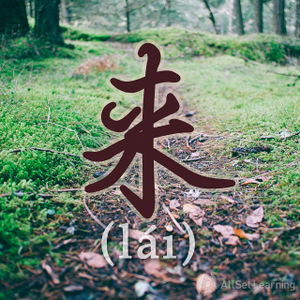Difference between revisions of "Direction complement "-qilai""
| Line 18: | Line 18: | ||
* 请 大家 <em>站 起来</em> 。<span class="pinyin">Qǐng dàjiā <em>zhàn qǐlái</em>.</span> <span class="trans">Everyone, please stand up.</span> | * 请 大家 <em>站 起来</em> 。<span class="pinyin">Qǐng dàjiā <em>zhàn qǐlái</em>.</span> <span class="trans">Everyone, please stand up.</span> | ||
* 快 把 地上 的 书 <em>捡 起来</em>。<span class="pinyin">Kuài bǎ dìshàng de shū <em>jiǎn qǐlái</em>. </span><span class="trans">Quickly pick up the books on the floor. </span> | * 快 把 地上 的 书 <em>捡 起来</em>。<span class="pinyin">Kuài bǎ dìshàng de shū <em>jiǎn qǐlái</em>. </span><span class="trans">Quickly pick up the books on the floor. </span> | ||
| − | * 你 怎么 不 把 老人 <em>扶 起来</em> ? <span class="pinyin">Nǐ zěnme bù bǎ lǎorén <em>fú | + | * 你 怎么 不 把 老人 <em>扶 起来</em> ? <span class="pinyin">Nǐ zěnme bù bǎ lǎorén <em>fú qǐlái</em>? </span> <span class="trans"> Why didn't you keep the old man upright? </span> |
| − | * 别 动 ! 把 手 <em>举 起来</em> 。 <span class="pinyin">Bié dòng! Bǎ shǒu <em>jǔ | + | * 别 动 ! 把 手 <em>举 起来</em> 。 <span class="pinyin">Bié dòng! Bǎ shǒu <em>jǔ qǐlái</em>. </span> <span class="trans">Don't move! Put your hands up. </span> |
</div> | </div> | ||
Revision as of 08:16, 3 March 2017
-
Level
-
Similar to
-
Used for
-
Keywords
起来 (qǐlái) comes up very frequently in Chinese and can be used both literally and figuratively. This is a little like the usage of "up" in English which can be used literally, as in "stand up," or figuratively, as in "add up."
Contents
Expressing an upward movement
Structure
起来 can be used to express an upward movement like "up", as in the English examples of "stand up" or "pick up."
Verb + 起来
Examples
- 请 大家 站 起来 。 Everyone, please stand up.
- 快 把 地上 的 书 捡 起来。Quickly pick up the books on the floor.
- 你 怎么 不 把 老人 扶 起来 ? Why didn't you keep the old man upright?
- 别 动 ! 把 手 举 起来 。 Don't move! Put your hands up.
Expressing initiation of an action
Structure
起来 can also be used to show that an action or state has started and is ongoing:
Verb / Adj. + 起来 +了
Examples
- 大家 笑 起来 了。Everyone started laughing.
- 宝宝 哭 起来 了。The baby started crying.
- 两 个 大妈 吵 起来 了。Two middle-aged ladies started arguing.
- 天气 热 起来 了。It's starting to get hot.
- 他 的 病 好 起来了。His illness is starting to get better.
When used like this, 起来 is only used with spontaneous actions, like 唱, 跳, 聊, or with states like 热, 冷, or 好 etc. It cannot be used with planned actions.
- 我们 做饭 起来 吧。
- 我们 开始 做饭 吧。
Expressing an initial judgement
起来 can also be used to express a preliminary judgement. 起来 is used here to express that the speaker has only just initiated an action, and based on that, has made a quick judgement. It is used in the following structure:
Structure
Subj. + Verb + 起来 + Adj.
This expresses that the subject seems adjective when the action of the verb is performed. This structure is frequently used with perception verbs such as 看, 听, 尝 etc.
Examples
- 他 看 起来 很 友好。He looks very friendly.
- 这 件 事情 听 起来 有点 复杂。This matter sounds a little bit complex.
- 你 点 的 菜 尝 起来 不错。The dishes that you ordered taste good .
- 这 件 衣服 摸 起来 很 舒服。These clothes feel very comfortable.
See Also
Sources and further reading
Books
- Chinese Grammar - Broken down into 100 items - Basic and Intermediate Levels (汉语语法百项讲练 - 初中级) (pp. 25-31) →buy
- Boya Chinese Elementary Starter 2 (博雅汉语初经起步篇) (pp. 80)→buy
- New Practical Chinese Reader 5 (新实用汉语课本5) (pp. 134-5)→buy
- 40 Lessons for Basic Chinese Course (基础汉语40课下册) (pp. 355-6)→buy
- Integrated Chinese: Level 2, Part 2 (p. 20) →buy
Websites



